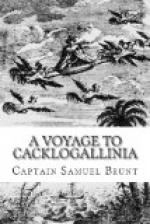Author: Captain Samuel Brunt
Release Date: July 4, 2005 [eBook #16202]
Language: English
Character set encoding: ISO-646-us (us-ASCII)
***Start of the project gutenberg EBOOK A voyage to Cacklogallinia***
E-text prepared by David Starner, Louise Hope, William Flis, and the Project Gutenberg Online Distributed Proofreading Team (http://www.pgdp.net)
Note: Project Gutenberg also has an HTML version
of this file which
includes the original
illustration.
See 16202-h.htm
or 16202-h.zip:
(http://www.gutenberg.ne
t/dirs/1/6/2/0/16202/16202-h/16202-h.htm)
or
(http://www.gutenberg.ne
t/dirs/1/6/2/0/16202/16202-h.zip)
Transcriber’s note: The 18th-century text
showed direct quotation in a
number
of ways, including italics and continuous
quotation
marks. In this e-text, longer italicized
passages
are shown as block quotes (indented)
without
quotation marks, while passages with marginal
quotes
are shown as block quotes with quotation marks.
A
list of corrections to the text can be found at the
end
of the file.
A VOYAGE TO CACKLOGALLINIA
With a Description of the Religion, Policy, Customs and Manners of that Country
by
CAPTAIN SAMUEL BRUNT
Reproduced from the Original Edition, 1727, with an Introduction by
MARJORIE NICOLSON
Published for
the facsimile text society
By Columbia University Press
New York: MCMXL
INTRODUCTION
A Voyage to Cacklogallinia appeared in London, in 1727, from the pen of a pseudonymous “Captain Samuel Brunt.” Posterity has continued to preserve the anonymity of the author, perhaps more jealously than he would have wished. Whatever his real parentage, he must for the present be referred only to the literary family of which his progenitor “Captain Lemuel Gulliver” is the most distinguished member. Like so many other works of that period, A Voyage to Cacklogallinia has sometimes been attributed to Swift; its similarities to the fourth book of Gulliver’s Travels are unmistakable. Again, the work has sometimes been attributed to Defoe. There is, however, no good reason to believe that either Defoe or Swift was concerned in its authorship, except in so far as both gave impetus to lesser writers in this form of composition.




